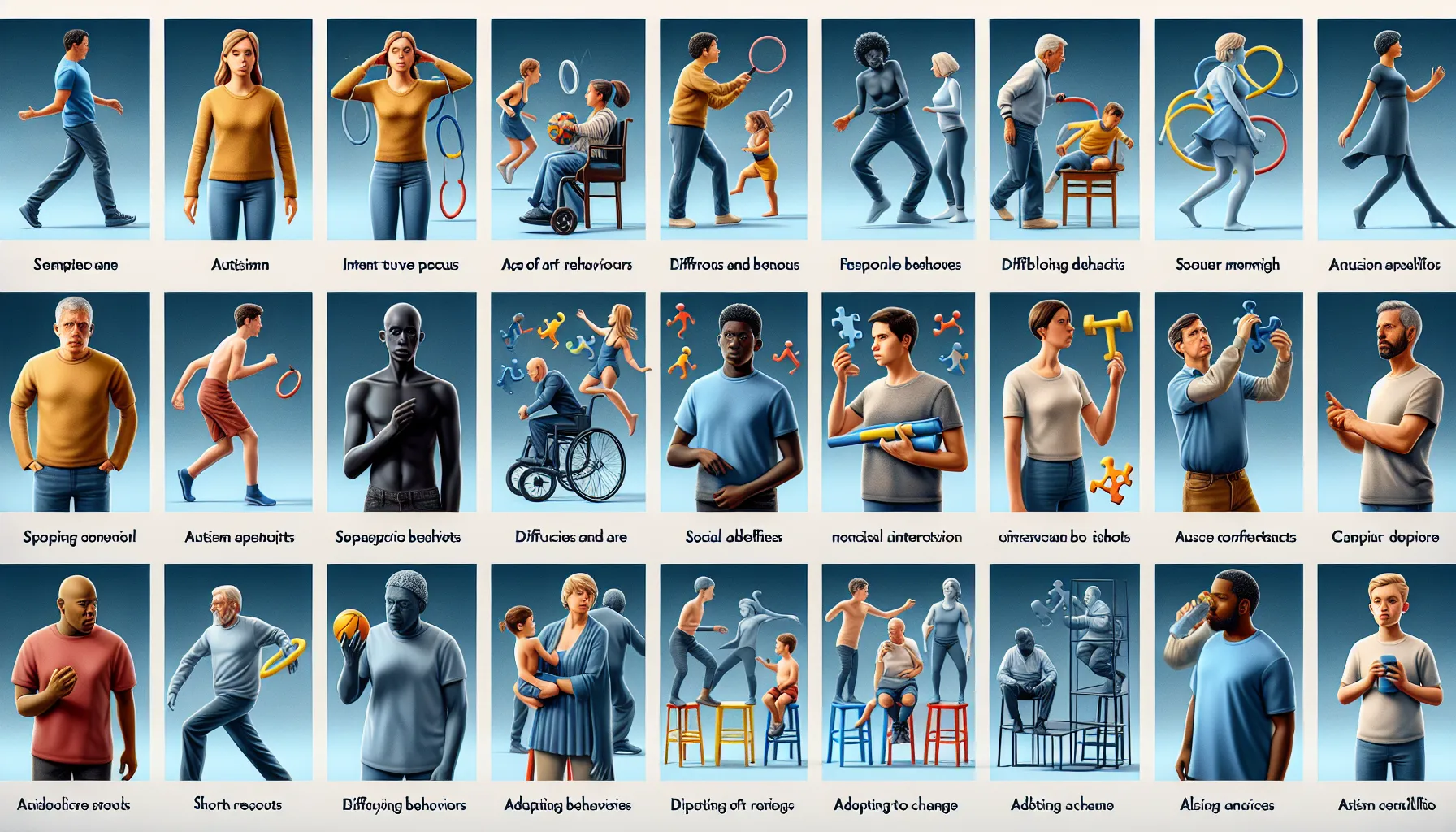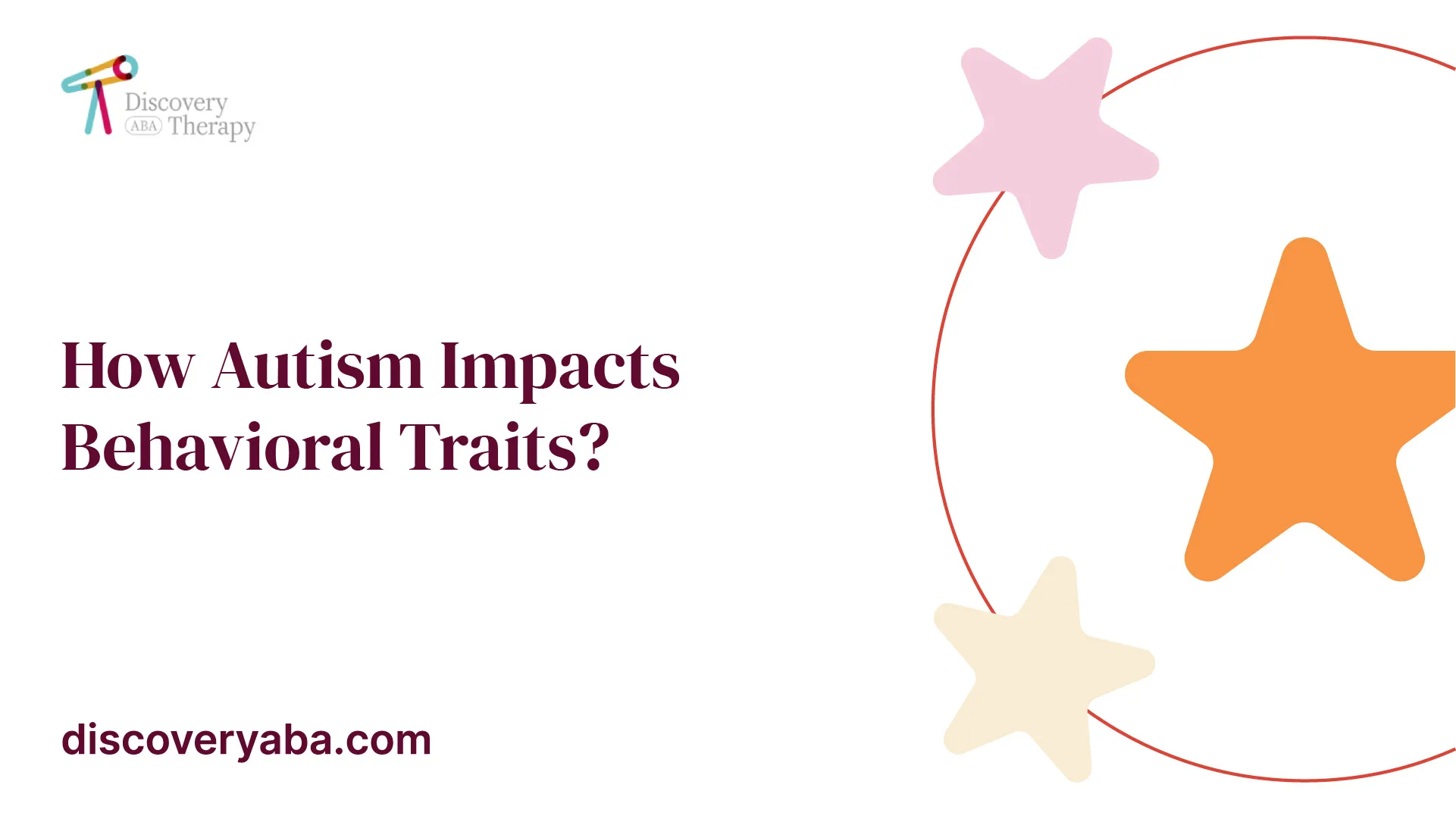How Autism Impacts Behavioral Traits?
Unlocking the mysteries of autism behavior. Discover how autism impacts behavioral traits and daily functioning.

Understanding Autism Behavior
To comprehend how autism affects behavior, it's important to recognize the spectrum of behavioral characteristics associated with autism spectrum disorders (ASD). These behaviors are responses to how individuals with ASD process their immediate environment.
Spectrum of Behavioral Characteristics
Autism is a spectrum disorder, encompassing a range of behavioral characteristics. The behaviors exhibited by individuals with ASD can vary from classic autism to high-functioning autism, including Asperger's syndrome. Each person's behavior is unique and influenced by various factors, such as their neurological development and individual experiences.

Social Communication Impairments
One of the defining features of ASD is social communication impairments. All individuals with ASD exhibit challenges in social communication, which can manifest in various ways. These may include a lack of appropriate eye contact, difficulty initiating or responding to joint attention, and challenges in understanding and using nonverbal cues.
It is important to note that while individuals with ASD may face difficulties in social communication, they still possess the desire for social connection and interaction. However, they may require additional support and strategies to navigate social situations effectively.
Understanding the spectrum of behavioral characteristics and social communication impairments associated with autism is crucial in promoting inclusivity and fostering a supportive environment for individuals with ASD. By recognizing and accommodating these unique behavioral traits, we can facilitate better understanding and acceptance of individuals on the autism spectrum.
Language and Behavior
When examining the impact of autism on behavior, it's essential to consider how language abilities and nonverbal communication are affected.
Receptive and Expressive Language Challenges
Individuals with autism spectrum disorder (ASD) may experience difficulties in both receptive and expressive language skills. Receptive language refers to the ability to understand and comprehend spoken or written language, while expressive language involves the ability to express thoughts, ideas, and desires through speech or written communication.
Some individuals with autism may be nonverbal and rely on alternative means of communication, such as communication devices or visual supports, to express themselves. Others may have limited verbal communication skills and struggle with articulating their thoughts and feelings. These challenges can significantly impact daily interactions and social communication.
Nonverbal Communication
Nonverbal communication plays a crucial role in human interaction, and individuals with autism may face difficulties in this area. Autistic individuals may utilize various nonverbal cues and behaviors to communicate their needs and wants. These can include gestures, crying, leading someone to an object, gazing at an object, reaching, using pictures, showing signs of distress, and echolalia (repeating words or phrases).
Echolalia, a common behavior in autism, involves repeating words or phrases without necessarily understanding their meaning. It can be a way for individuals to communicate or self-soothe. Supporting individuals with echolalia may involve using visual supports or offering choices to help them express their needs effectively [3].
The stages of communication development in autism encompass different levels of interaction and communication abilities. These stages include the own agenda stage, requester stage, early communicator stage, and partner stage. Each stage represents progress in communication skills and the ability to engage in more complex interactions [3].
For individuals with autism who struggle with spoken language, augmentative and alternative communication (AAC) supports can be beneficial. AAC methods, such as Picture Exchange Communication System (PECS), sign language, communication boards, and voice output communication aids, provide alternative means for individuals to express their needs and communicate effectively.
Understanding the challenges related to language and nonverbal communication is essential in supporting individuals with autism in their social interactions and daily functioning. By recognizing and addressing these specific needs, we can help individuals with autism navigate the world around them more effectively and enhance their overall well-being.
Repetitive Behaviors and Interests
Individuals with autism spectrum disorder (ASD) often exhibit repetitive behaviors and a limited repertoire of interests. Understanding these patterns is crucial in decoding the connection between autism and behavioral traits.
Patterns in Behavior and Interests
People with ASD may display repetitive behaviors and engage in specific interests or activities, which can be due to a limited repertoire of alternative behaviors or a preference for certain tasks [2]. These behaviors can manifest in various ways, such as repetitive motions (e.g., hand flapping, rocking), adherence to rigid routines, or a fixation on specific objects or topics.
Repetitive behaviors can serve different functions for individuals with autism. Some engage in these behaviors as a way to self-soothe or reduce anxiety, while others may find comfort or enjoyment in the predictability and familiarity of repetitive actions. It's important to note that not all repetitive behaviors are detrimental or problematic. However, when these behaviors interfere with daily functioning or social interactions, they may require support or intervention.
Limited Repertoire of Behaviors
Individuals with ASD may exhibit a limited repertoire of behaviors or interests, focusing intensely on a few specific topics or activities. This narrow focus can sometimes result in a depth of knowledge or expertise in those particular areas. For example, a person with autism might have an exceptional memory for facts about dinosaurs or possess an intricate understanding of train schedules.
While having a specialized interest can be a positive aspect of autism, it may also pose challenges in social interactions and flexibility. Individuals with ASD may struggle to engage in conversations or activities outside their specific interests or find it difficult to adapt to changes in routines. Encouraging exposure to a broader range of activities and providing opportunities for socialization can help expand their repertoire and enhance their overall well-being.
Understanding and respecting the unique patterns of behavior and interests in individuals with autism is crucial for promoting acceptance and inclusion. By embracing their strengths and providing appropriate support, we can create an environment that fosters growth, independence, and a sense of belonging.
Sensory Differences in Autism
Autism is often associated with sensory differences, which can significantly impact an individual's behavior and daily functioning. These sensory differences can manifest as either hypo- or hypersensitivity to various sensory inputs. Let's explore the implications of sensory differences in autism and their impact on daily functioning.
Hypo and Hypersensitivity
According to the Indiana Resource Center for Autism, individuals with Autism Spectrum Disorder (ASD) may exhibit sensory differences, being either hypo- or hypersensitive to various sensory stimuli. Over 96% of children with ASD report hyper- and hypo-sensitivities in multiple domains, ranging from mild to severe and enduring through adulthood [4].
Hypersensitivity refers to an increased sensitivity to sensory stimuli. Autistic individuals may experience hypersensitivity in any of their senses, such as touch, sound, sight, taste, or smell. Everyday sensory inputs that may be tolerable for neurotypical individuals can become overwhelming for those with hypersensitivity. This can lead to sensory overload, resulting in stress, anxiety, and possibly physical pain [5].
On the other hand, individuals with autism may also experience hyposensitivity, which refers to reduced sensitivity to sensory stimuli. They may require an increased level of sensory input to register sensations that others perceive as normal. For example, they may seek out intense stimuli or engage in repetitive behaviors to fulfill their sensory needs.
Impact on Daily Functioning
Sensory differences have a profound impact on the daily lives of individuals with autism. Sensory overload can lead to various challenges and behavioral responses. Autistic individuals may exhibit withdrawal, distressed behavior, or meltdowns as a result of difficulties in processing everyday sensory information [5].
Managing sensory differences is crucial for individuals with autism. Small changes in the environment can make a significant difference in reducing sensory overload and supporting their well-being. Creating a sensory-friendly environment that takes into account their sensory needs can help minimize distress and enhance their ability to engage in daily activities.
It's important to note that sensory differences vary from person to person, and the specific sensitivities can also change over time. Understanding and accommodating these sensory differences is essential to support individuals with autism in their daily lives. By promoting an environment that respects and addresses their sensory needs, we can help improve their overall well-being and quality of life.
Executive Functioning Impairments
Executive functioning impairments are a common characteristic of autism spectrum disorder (ASD) that can significantly impact various aspects of daily life. These impairments affect advanced cognitive skills, including attention, working memory, planning, reasoning, sequencing, and flexible thinking. As a result, individuals with ASD may face challenges in social interactions, academics, learning, self-regulation, and daily living activities.
Cognitive Skills Affected
Attention is a crucial cognitive skill that impacts every stage of sensory processing in individuals with ASD. Heightened reactivity to stimuli and narrowed interests may be related to neurobehavioral-driven distractibility and deficits in attentional shifting. Some individuals with ASD may have difficulty with selective attention, particularly in challenging sensory environments.
Studies have reported structural differences in attentional functions between individuals with ASD and those with attention deficit hyperactivity disorder (ADHD). While some suggest that these disorders present identical deficiencies, others propose that they have distinct attentional traits that distinguish them from ADHD [6].
Impact on Daily Activities
The impairment of executive functioning skills can significantly impact daily activities for individuals with ASD. Difficulties in attention, working memory, and planning can make it challenging to stay focused, complete tasks, and organize daily routines. These challenges may affect academic performance, job functions, and the ability to navigate daily responsibilities effectively.
Additionally, deficits in flexible thinking and reasoning can lead to difficulties in adapting to changes, problem-solving, and adjusting to unexpected situations. These challenges may result in increased stress and anxiety, as individuals with ASD may struggle to cope with unexpected changes in their environment or routine.
To support individuals with executive functioning impairments, strategies such as visual schedules, task lists, and environmental modifications can be beneficial. Breaking tasks into smaller, more manageable steps and providing clear instructions can also help individuals with ASD navigate daily activities more effectively.
Understanding the impact of executive functioning impairments in individuals with ASD is crucial for developing appropriate support and intervention strategies. By providing targeted support in areas such as attention, working memory, planning, reasoning, sequencing, and flexible thinking, individuals with ASD can better navigate their daily lives and achieve greater independence.
Development and Outcomes
As individuals with autism progress through different stages of life, their behavioral characteristics and outcomes may undergo changes. Understanding these developmental aspects is crucial for providing appropriate support and intervention. In this section, we will explore the behavioral changes over time and the comorbidities and outcomes associated with autism.
Behavioral Changes Over Time
Research has shown that autism symptoms and maladaptive behaviors can improve over time. A study conducted over an 8.5 year period observed a general trend of improvement in symptoms among adolescents and adults with autism spectrum disorder (ASD). Similar studies have also reported age-related differences in the severity of autism symptoms, with a general pattern of improvement as individuals age.
Maladaptive behaviors, including self-injurious behavior, withdrawal, uncooperative behavior, aggression, and destruction of property, have been found to decrease with age among individuals with ASD. These improvements in behavior can have a significant impact on the quality of life for individuals with autism and their families.
Comorbidities and Outcomes
Comorbidities, such as intellectual disability (ID), can influence the outcomes and prognosis of individuals with ASD. Those with comorbid ID generally have worse outcomes in adulthood compared to individuals with ASD without ID. However, it's important to note that outcomes can vary greatly among individuals with autism, and each person's journey is unique.
Positive family processes and supportive environments have been associated with improved outcomes for individuals with ASD. Higher levels of maternal praise and higher quality mother-child relationships have shown to positively impact outcomes. It highlights the importance of a nurturing and supportive family environment in promoting positive developmental outcomes for individuals with autism.
While there may be improvements in certain behavioral traits over time, it's essential to understand that autism is a lifelong condition. Ongoing support, interventions, and therapies are crucial in helping individuals with autism reach their full potential and lead fulfilling lives.
Understanding the developmental trajectory of autism and its associated comorbidities can assist caregivers, educators, and healthcare professionals in tailoring interventions and support strategies to meet the specific needs of individuals with autism spectrum disorder. By providing appropriate resources and fostering a supportive environment, we can enhance the outcomes and well-being of individuals with autism throughout their lifespan.
References
Does Your Child Have An Autism Diagnosis?
Learn More About How ABA Therapy Can Help
Find More Articles
Contact us
North Carolina, Nevada, Utah, Virginia
New Hampshire, Maine
Arizona, Colorado, Georgia, New Mexico, Oklahoma, Texas
.avif)




































































































